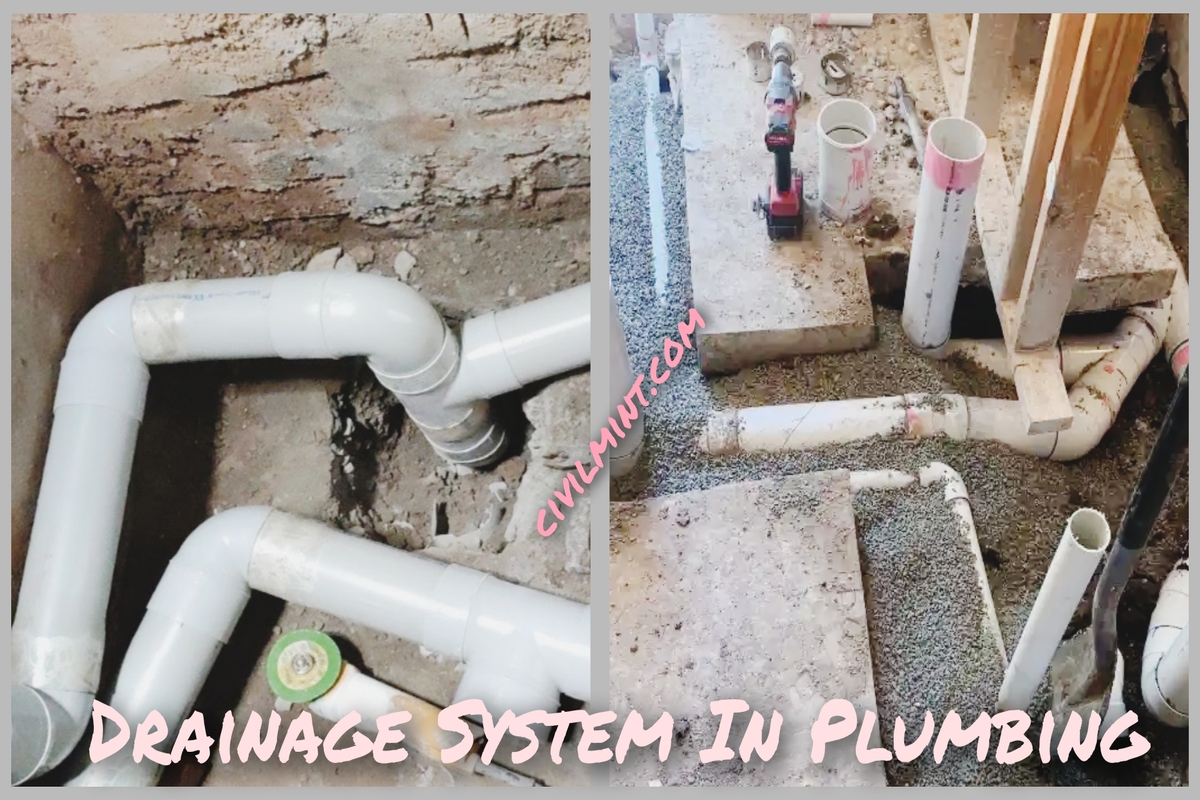A plumbing drainage system is designed to transport wastewater from various fixtures and discharge it into either a septic tank or the main sewer line, while ensuring that clean water remains uncontaminated and there are no leaks of sewage.

Table of Contents
What Is Drainage System In Plumbing?
Drainage System in plumbing refers to the system of pipes used for the removal of wastewater from a building.
The purpose of the drainage system is to transport liquid waste, such as sewage and rainwater, to a point of disposal, either in the sewer system or septic tank.
The system is designed to prevent the buildup of sewer gases, which can be harmful to human health.
Typically, the piping used in a drainage system is made of plastic or metal, and it is separate from the piping that brings water into a building.
Proper installation and maintenance of the drainage system are essential to ensure its effectiveness and to avoid costly repairs and health hazards.
Working Concept
Clean and fresh water comes from a water source like a well or a water service, and is sent to each plumbing fixture through pipes. When you use a fixture like a sink or a toilet, the used water and waste go through a drain line and into the main drain system by gravity.
To make sure the water flows properly, all drain lines are built at a slight angle. The main drain line connects to either a municipal sewer line or a septic tank on the property.
Vent pipes are attached to the drain lines at each fixture and protrude through the roof. They help regulate the air pressure in the drain system so water can flow freely. The pipes are capped to keep animals and rain out but still allow air to flow in.
Traps in the drainpipe collect dirty water and seal the pipe to keep sewer gases out of the building. There are two types of traps: S and P. S-traps are used in toilets, while P-traps are used in sinks, tubs, and showers.
Common Issues with Drainage Systems and their Solutions
1. Clogged Drain: Causes And Solution
Causes of Clogged Drains: A clogged drain occurs when hair or other debris build up inside the drainpipe. This can be caused by a number of factors, such as flushing inappropriate items down the drain or the accumulation of soap scum.
Solutions to Clear Clogged Drains: Pouring drain cleaner down the drain can often clear clogged drains. However, if the cleaner doesn’t work, a plumber can use a tool called a “snake” to manually remove the blockage, or remove the P-trap to clear the debris.
2. Sewer Line Break or Leak: Detection and Repair
Identifying Sewer Line Break or Leak: If the main sewer line underground has a leak or a pipe breaks, sewer water can contaminate the ground. Signs of a sewer line break include unpleasant odors, sewage backups, and slow draining water. A plumber can locate the leak by isolating the line and using a video camera to inspect it.
Repairing Sewer Line Break or Leak: Depending on the extent of the damage, a plumber may be able to replace a section of the pipe or repair it with a patch. In some cases, excavation may be required to access and repair the damaged pipe.
3. Septic Tank Break or Leak: Repair and Replacement
Detecting Septic Tank Break or Leak: Like a sewer line break, a septic tank leak can cause contamination. Signs of a septic tank break or leak include unpleasant odors, standing water or lush vegetation around the septic tank area. A plumber or septic specialist can inspect the tank to determine the cause of the problem.
Repairing or Replacing Septic Tank: Depending on the severity of the problem, the septic tank may be repaired or replaced. Repairs may involve fixing cracks or replacing broken parts, while replacement may be necessary if the tank is old or damaged beyond repair.
Advantages Of Drainage System In Plumbing
1. Keeps things dry:
A drainage system helps to stop water from gathering in places where it can cause harm. This stops water from damaging walls, floors, and ceilings, which can be expensive to fix.
2. Stays clean:
A drainage system helps to keep things clean by taking away dirty water and stopping bad smells from developing. It also stops insects and rodents from making homes in the water.
3. Protects buildings:
A drainage system protects the base of a building from being damaged by water. When water builds up around the base, it can make cracks and weaken the building. A drainage system helps keep water away from the building and keeps it safe.
4. Saves money:
A well-made drainage system helps to save money by stopping things from blocking and leaks from happening. Taking care of the drainage system can help it work better for a long time.
5. Makes things worth more:
A good drainage system is important for any building, and it makes it worth more money. When someone wants to buy a building, they look at the drainage system to make sure it is working well. If it is, then the building can be worth more money.
